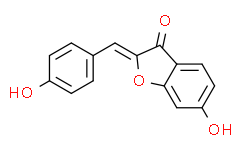| Cas No.: | 5786-54-9 |
| Chemical Name: | Hispidol |
| Synonyms: | (2Z)-6-hydroxy-2-[(4-hydroxyphenyl)methylidene]-1-benzofuran-3(2H)-one;6,4''-DIHYDROXYAURONE;(Z)-hispidol;2-(4'-hydroxybenzylidene)-6-hydroxybenzofuran-3(;4',6-dihydroxy-2-(phenylmethylene)-3(2H)-benzofuranone;6-hydroxy-2-(4-hydroxy-3-methoxyphenyl)-4H-chromen-4-one;6-hydroxy-2-(4-hydroxy-3-methoxy-phenyl)-chromen-4-one;6-hydroxy-2-(4-hydroxybenzylidene)-3(2H)-benzofuran-3-one;6-hydroxy-2-(4-hydroxy-benzylidene)-benzofuran-3-one;AC1LILDE;CHEMBL424829;CTK1I8410;Oprea1_050329;STOCK1N-33228;Hispidol;(Z)-4',6-Dihydroxyaurone;NSC356828;3(2H)-Benzofuranone, 6-hydroxy-2-((4-hydroxyphenyl)methylene)-, (2Z)-;3(2H)-Benzofuranone, 6-hydroxy-2-[(4-hydroxyphenyl)methylene]-, (2Z)-;ZE-Hispidol;4',6-Dihydroxyaurone;6,4' -dihydroxy aurone;Isoliquiritigenin metabolite M6;CS1235I0WT;BDBM50180260;C08644;Benzofuran-6-ol-3-one, 2-[4-hydroxybenzy |
| SMILES: | O1/C(=C(/[H])\C2C([H])=C([H])C(=C([H])C=2[H])O[H])/C(C2C([H])=C([H])C(=C([H])C1=2)O[H])=O |
| Formula: | C15H10O4 |
| M.Wt: | 254.2375 |
| Purity: | >98% |
| Sotrage: | 2 years -20°C Powder, 2 weeks 4°C in DMSO, 6 months -80°C in DMSO |
| Description: | Hispidol ((Z)-Hispidol) is a potential therapeutic for inflammatory bowel disease; inhibits TNF-α induced adhesion of monocytes to colon epithelial cells with an IC50 of 0.50 µM. |
| In Vivo: | The oral administration of hispidol suppresses significantly and dose-dependently TNBS-induced rat colitis. Oral administration of hispidol suppresses TNBS-induced colitis in a dose-dependent manner. There is a significant recovery in body weight decrease and colon tissue edematous inflammation. A higher dose (30 mg/kg) of hispidol shows a similar recovery effect to that of 300 mg/kg sulfasalazine. In the colon tissues, TNBS induces a dramatic increase in the level of MPO, a biochemical marker of inflammation, which is suppressed significantly by hispidol in a dose-dependent manner[1]. |
| In Vitro: | Hispidol shows potent inhibitory effect (>70%) on the TNF-α-induced adhesion of monocytes to colon epithelial cells, which is one of the hallmark events leading to inflammatory bowel disease (IBD). Hispidol shows strong inhibitory activities against TNF-α-induced monocytic-colonic epithelial cell adhesion as well as LPS-induced TNF-α expression, is as an excellent candidate for IBD drug development. This inhibition of TNF-α expression by hispidol corresponds to the additional inhibitory activity against AP-1 transcriptional activity, which is another transcription factor required for high level TNF-α expression[1]. |
| Animal Administration: | Rats: To study the effect of the drugs, hispidol (10 or 30 mg/Kg/day in corn oil) is administered orally once in a day, until 5 days after TNBS administration. The doses of 10 or 30 mg/kg are selected based on previous studies. The concentration of the compound inhibiting 70% and 90% (µM) cell-to-cell adhesion is selected and regarded as the in vivo test dose (mg/kg). Sulfasalazine (300 mg/Kg/day) is administered in corn oil as a positive control. On the 6th day, the rats are sacrificed and the severity of colitis and macroscopic ulceration are evaluated by two independent investigators who are blinded to the experiments. The colon tissues (5-7 cm proximal to rectum) are cut and used to measure the amount of myeloperoxidase and for the histological examinations[1]. |
| References: | [1]. Kadayat TM, et al. Discovery and structure-activity relationship studies of 2-benzylidene-2,3-dihydro-1H-inden-1-one and benzofuran-3(2H)-one derivatives as a novel class of potential therapeutics for inflammatory bowel disease. Eur J Med Chem. 2017 Sep 8;137:575-597. |

 DC Chemicals' products qualify for U.S. tariff exemptions. We guarantee no price increases due to customs duties and maintain stable supply, continuing to deliver reliable research solutions to our American clients.
DC Chemicals' products qualify for U.S. tariff exemptions. We guarantee no price increases due to customs duties and maintain stable supply, continuing to deliver reliable research solutions to our American clients.





















